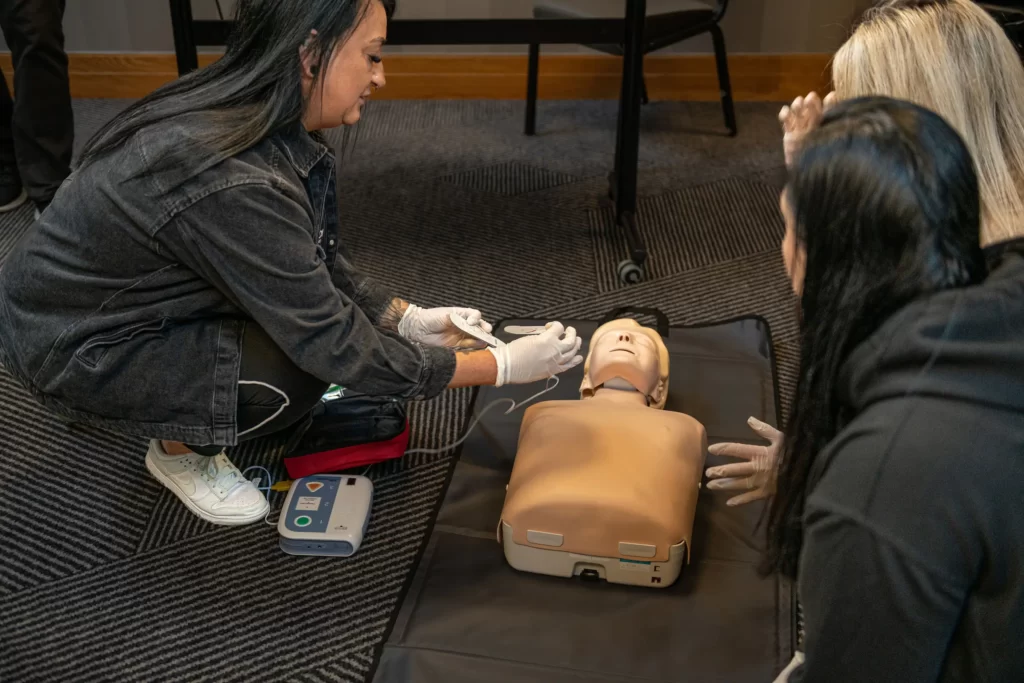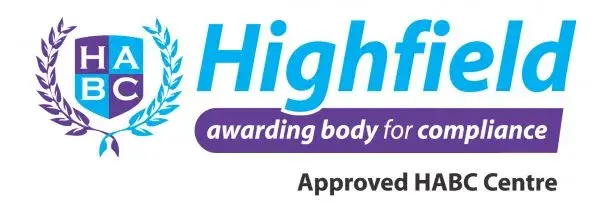In any workplace, safety should be a top priority. Accidents and medical emergencies can occur at any time, making it crucial for employees to possess the necessary skills and knowledge to respond effectively.
This is where First Aid at Work training courses play a vital role, equipping employees with life-saving techniques, empowering them to take immediate action in the face of an emergency.
In this blog post, we will explore the significance of First Aid at Work training and highlight the key things that employees need to know.
Understanding the Importance of First Aid:
First things first, it is important to establish what first aid is and how completing one of our courses can help you, your business, and your employees.
1. First Aid is the initial care provided to an injured or ill person before professional medical assistance arrives. It can make a significant difference in the outcome of an emergency situation. By undergoing a First Aid at Work course , employees gain the ability to assess and respond appropriately to a wide range of incidents, such as cardiac arrest, choking, bleeding, fractures, and more. Knowing how to administer proper First Aid can potentially save lives and minimize the impact of an injury or illness.
Course Content and Duration:
2. First Aid at Work training courses are typically comprehensive and cover a range of essential topics, with content often including:
A. Basic life support techniques, including CPR (Cardiopulmonary Resuscitation) and AED (Automated External Defibrillator) usage.
B. Recognition and management of different medical conditions such as heart attacks, strokes, seizures, and allergic reactions.
C. Assessing and treating common injuries like burns, fractures, sprains, and wounds.
D. Dealing with workplace-specific incidents, such as chemical exposures, electrical injuries, and manual handling accidents.
E. Communication and incident reporting procedures to ensure effective coordination with emergency services.
The duration of your first aid at work course may vary depending on the level of training, ranging from one to three days. Employers need to select a course that aligns with their workplace’s specific needs and risks, ensuring it is suitable and relevant for their employees.
Legal Requirements:
In many countries, there are legal obligations for employers to provide First Aid at Work training to their employees. These requirements vary, but the underlying principle is to ensure a safe working environment. Compliance with these regulations not only helps meet legal obligations but also demonstrates a commitment to employee welfare.

Benefits for Employees:
First Aid at Work training offers several benefits for employees, including:
Enhanced safety awareness
Training helps employees develop a proactive mindset toward safety, enabling them to identify and mitigate potential risks.
Confidence and empowerment
By acquiring First Aid skills, employees gain the confidence to handle emergency situations calmly and efficiently. This empowerment can positively impact both their personal and professional lives.
Team cohesion
Training sessions often involve practical exercises and simulations, fostering teamwork and communication among employees.
Career development
First Aid certification can be a valuable addition to an employee’s resume, as it showcases their commitment to personal growth, responsibility, and ability to handle challenging situations.
Periodic Refresher Training:
First Aid skills, like any other knowledge, require regular reinforcement, to ensure employees maintain their proficiency, which is why periodic refresher courses are recommended. These courses provide an opportunity to review and update skills, learn about new techniques or guidelines, and address any questions or concerns that may have arisen since the initial training.
There are 5 principles of First Aid, serving as a guiding framework for providing effective and appropriate care to an injured or ill person. These principles are commonly known as the “DR ABCs” of First Aid:
Danger:
1. The first principle is checking if there is any immediate danger,and assessing the scene to make sure it is safe. If it is not safe, do not go any further, or make it safe before approaching the casualty.
Response:
2. The second principle is checking to see if the casualty is responsive. Ask them a loud question, squeeze their shoulders, do they respond? If not, shout for help!
Airway:
3. The third principle involves checking and establishing a clear airway for the casualty. If the person is conscious, ask if they can speak or cough. If they are unable to speak, their airway may be partially or completely blocked. In such cases, the airway should be cleared by tilting the casualty’s head back gently while lifting the chin forward. This helps to open the airway and ensures a clear passage for breathing.
Breathing:
4. The fourth principle focuses on assessing the casualty’s breathing. After ensuring an open airway, observe for normal breathing or signs of breathing difficulties. Look, listen, and feel for breathing by watching for chest movements, listening for breath sounds, and feeling for air on your cheek. If the person is not breathing normally or not breathing at all, immediate action must be taken to start CPR (Cardiopulmonary Resuscitation) to maintain circulation and oxygenation.
Circulation:
5. The fifth principle involves assessing the casualty’s circulation. Check for signs of a pulse or any severe bleeding. If there is no pulse or if severe bleeding is present, it is necessary to start CPR and control the bleeding using appropriate techniques, such as applying direct pressure or using a tourniquet if required. Maintaining circulation is vital to deliver oxygen-rich blood to the vital organs.

Why is First Aid training important?
1. mmediate Response to Emergencies: Accidents and medical emergencies can occur unexpectedly in any work environment. Having employees trained in First Aid ensures that there are individuals capable of providing immediate assistance until professional medical help arrives. This prompt response can significantly improve the chances of a positive outcome and reduce the severity of an injury or illness.
2. Prevention of Further Harm: In the critical moments following an incident, administering appropriate First Aid techniques can help prevent further harm or complications. Actions such as stopping bleeding, immobilizing fractures, or clearing airways can minimize the impact of an injury and stabilize the casualty’s condition until advanced medical care is available.
3. Saving Lives: First Aid training equips employees with life-saving skills, particularly in situations such as cardiac arrest, choking, or severe bleeding. The ability to perform CPR, use an AED (Automated External Defibrillator), or control bleeding can make a crucial difference in saving someone’s life before emergency medical services arrive.
4. Workplace Safety Culture: Implementing First Aid measures in the workplace fosters a safety-conscious culture. It shows employees that their well-being is a top priority for the organization. By providing First Aid training and resources, employers demonstrate their commitment to creating a safe work environment and caring for their workforce.
5. Compliance with Legal Requirements: In many jurisdictions, there are legal obligations for employers to provide First Aid provisions in the workplace. These requirements may include having trained First Aiders, adequate First Aid kits, and appropriate emergency response protocols. Complying with these regulations not only helps meet legal obligations but also promotes a safe and compliant working environment.
6. Employee Empowerment and Confidence: First Aid training empowers employees with the skills and knowledge needed to respond effectively during emergencies. This empowerment boosts their confidence and enables them to take quick, decisive action when faced with a medical crisis. Feeling prepared and capable of handling emergencies contributes to employee well-being and job satisfaction.
7. Prompt Return to Work: By providing immediate and appropriate First Aid, employees who experience injuries or illnesses at work can receive timely care, which may facilitate a quicker recovery process. When injuries are promptly addressed, employees can potentially return to work sooner, reducing work disruptions and associated costs.
8. Public Perception and Reputation: Demonstrating a commitment to workplace safety and having trained First Aiders can positively influence the public perception of an organization. Customers, clients, and business partners are more likely to trust and engage with companies that prioritize the well-being of their employees.
Conclusion
First Aid at Work training courses are a critical investment for employers seeking to create a safe and secure work environment. Equipping employees with life-saving skills not only improves the chances of a positive outcome during an emergency but also instills a culture of safety in the workplace. By empowering employees with First Aid knowledge, employers can foster a sense of responsibility, confidence, and well-being, creating a workplace where everyone feels protected and supported.
If you have any additional questions or want to know more information, do not hesitate to contact our expert team of Buddies now to discuss your training options.
How Can We Help?
Here at Buddy, we are experts in workplace training, with a team of dedicated and qualified instructors on hand to deliver your training and give you the skills you need to ensure your safety and the safety of those around you.
Are you interested in completing one of our First Aid at Work training courses? Book online now to secure your space or up to 12 spaces, as part of a team training session.
Not what you were looking for? We have an extensive range of other workplace training courses available to book online now, including Food Safety Hygiene training, and Business Training courses.

